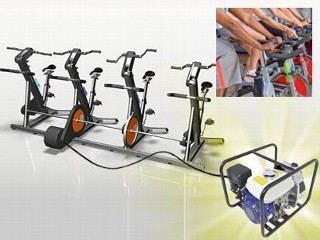It sounds like something you'd only see on the Discovery Channel: people pedaling ferociously to create enough energy to power the television, stereo and lights.
But for Adam Boesel, owner of the Green Microgym in Portland, Ore., and his partners, this could be the future.
Launched last week, his "human-powered" gym is one of few fitness centers in the world that runs on power generated by people working out, Boesel said.
As members pedal on stationary bicycles, a small motor connected to the stations charges batteries that power the gym's television and stereo system.
Boesel said he doesn't yet have a way to quantify the output but knows that at the moment it's relatively small. However, this is just the beginning, he said.
"Our goal is to someday create 100 percent of the electricity we use in the gym," Boesel said. "The short-term goal is to get all of the electricity we can out of the machines."
In addition to three spin bikes Boesel re-engineered the gym features a new four-person machine that generates 200 to 400 watts of electricity an hour, depending on the fitness level of the group.
Created by El Paso, Texas-based Henry Works, the Team Dynamo connects hand cranks and foot pedals to a generator to capture as much human energy as possible.
"It's a little humbling -- a person can make about a penny's worth of electricity an hour. So it's not a lot," said Michael Tagget, president of Henry Works, adding that on his or her own, an individual can create 50 to 100 watts of electricity.
"But if 20, 30, 40 people are doing that in a gym, they can [create] all the electricity for entertainment systems. It's better than nothing and the feeling of accomplishing something is worthwhile," Tagget noted.
Although Tagget's company is starting with the commercial market -- the Green Microgym is the first gym to test the product -- it plans to offer a home unit in the spring.
Boesel's gym is also working with a St. Petersburg, Fla.-based startup called ReRev.com to implement a "grid-tie" system. Instead of using a battery-based system, ReRev.com's approach is to retrofit elliptical machines to harvest energy from the machines and send the electricity directly back into the electrical panel.
Power Gym of the Future
"These machines -- the way they're set up -- are normally emitting heat. If they run all day, they're putting out ambient heat into the facility. We've developed a system that doesn't emit heat in the facility but instead turns it into electricity," said Hudson Harr, president and founder of ReRev.com.Harr said his system is an improvement over battery-based approaches that require more maintenance and are less energy efficient. As energy passes through the battery, he said, some of it is lost.
ReRev.com retrofitted 15 machines at a Gainesville, Fla., fitness center in April and, Harr said, on average, that installation is producing between 2 and 7 kilowatts per day.
Although the Portland gym is one of the first facilities in the country to harness human energy, the technology has already been introduced in other parts of the world.
The California Fitness gym in Hong Kong uses a battery-based system to help supply power. The Sustainable Dance Club in Rotterdam, Netherlands, also relies on human-powered technology.
The company's literature says the dance floor is a movable surface composed of small modules. As people dance, the movement of the modules is converted into electricity that lights up the floor. An "energy meter" allows dancers to see the amount of energy they are creating.
Like the TVs and stereos in the gyms, this meter encourages participants to work harder to generate more energy.
Actor and environmentalist Ed Begley Jr. has been a long-standing fan of the human power. In 1990, he and a friend connected a bicycle to a 24-volt battery. On his cable reality show, "Living With Ed," airing on Planet Green TV, he has been known to make toast with energy created by pedaling his bicycle.
"I think as much human-powered exercise equipment as we can advance would be for the good," he told ABCNews.com. "I think that the idea of sitting on a life cycle and using power that is plugged into the wall ... is upside down."
The Emmy Award-winning host of the eponymous educational television program "Bill Nye the Science Guy" also gives the technology a thumbs up but cautions that it's not free of problems.
While the amount of energy a human can generate is not insignificant, it still requires a lot of work. For example, Henry Works' Tagget said he estimates that the average user of his power-generating cycling machine can create 100 watts per hour, which could power a smaller television for about an hour and fifteen minutes.
Nye also said that questions regarding energy storage persist.
Still, he said, "The idea is great. You see people going to the gym now in droves and they ride their bikes to nowhere, and so wouldn't it be nice to capture all that energy?"




No comments:
Post a Comment